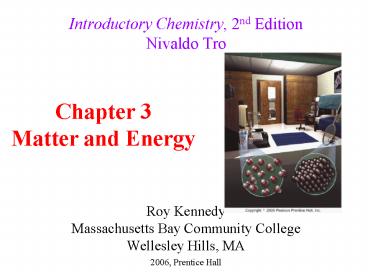Roy Kennedy PowerPoint PPT Presentation
1 / 46
Title: Roy Kennedy
1
Introductory Chemistry, 2nd EditionNivaldo Tro
Chapter 3 Matter and Energy
- Roy Kennedy
- Massachusetts Bay Community College
- Wellesley Hills, MA
2006, Prentice Hall
2
What is Matter?
- Matter is defined as anything that occupies space
and has mass
Matter is composed of a lot of tiny little pieces
we call atoms and molecules
3
Visible/measurable properties
Room temperature
4
- The motion and arrangement of the atoms or
molecules determine the physical state of matter.
5
Solids
- the particles in a solid are packed close
together and are fixed in position
6
Solids
- crystalline solids
- salt and diamonds
- amorphous solids
- plastic and glass
7
Liquids
- the particles are closely packed, move around and
have a random arrangement.
8
Gases
- the particles are widely separated, rapidly
moving, random.
9
Physical Change
freezing
evaporation
SOLID LIQUID
GAS
melting or fusion
condensation
10
Classification of Matter
- Pure Substance all samples are made of the same
atoms or molecules in the same percentages - salt
- Mixtures different samples may have the same
pieces in different percentages - salt water
11
Copper a Pure Substance
12
Brass a Mixture
13
Classifying Matter
14
Atoms Molecules
- Smallest piece of an element is called an atom
- there are subatomic particles, but these are no
longer the element - Smallest piece of a compound is called a molecule
- molecules are made of atoms
- all molecules of a compound are identical
- each molecule has the same number and type of
atoms
15
Properties of Matter
- Physical Properties are the characteristics of
matter that can be changed without changing its
composition - characteristics that are directly observable
- Chemical Properties are the characteristics that
determine how the composition of matter changes
as a result of contact with other matter or the
influence of energy - characteristics that describe the behavior of
matter
16
Some Physical Properties
17
Some Chemical Properties
18
3.6 Changes in Matter
19
Changes in Matter
20
Is it a Physical or Chemical Change?
21
Phase Changes arePhysical Changes
22
Separation of Mixtures
23
Distillation
24
Filtration
25
3.7 Law of Conservation of Mass
- Matter is neither created nor destroyed in a
chemical reaction
26
Conservation of Mass
- butane oxygen ? carbon dioxide water
- 58 grams 208 grams ? 176 grams 90
grams - 266 grams 266 grams
27
3.8 Energy
- Energy is anything that has the capacity to do
work
28
Law of Conservation of Energy
- Energy can neither be created nor destroyed
29
Matter Possesses Energy
- all chemical and physical changes result in the
matter changing energy
30
Kinds of EnergyKinetic and Potential
- Kinetic Energy is energy of motion, or energy
that is being transferred from one object to
another - Potential Energy is energy that is stored
31
Some Forms of Energy
32
Units of Energy
- calorie (cal) is the amount of energy needed to
raise one gram of water by 1C - kcal energy needed to raise 1000 g of water 1C
- food Calories kcals
Energy Conversion Factors
1 calorie (cal) 4.184 joules (J)
1 Calorie (Cal) 1000 calories (cal)
1 kilowatt-hour (kWh) 3.60 x 106 joules (J)
33
Example 3.5Conversion of Energy Units
34
- Example
- A candy bar contains 225 Cal of nutritional
energy. How many joules does it contain?
35
Heat
kinetic energy of the molecules in a sample
36
3.9 Temperature
- Temperature is a measure of the average kinetic
energy of the molecules in a sample - Not all molecules have in a sample the same
amount of kinetic energy - a higher temperature means a larger average
kinetic energy
37
Temperature Scales
100C
373 K
212F
BP Water
671 R
298 K
75F
534 R
Room Temp
25C
0C
273 K
32F
MP Ice
459 R
-38.9C
234.1 K
-38F
421 R
BP Mercury
-183C
90 K
-297F
BP Oxygen
162 R
BP Helium
-269C
4 K
-452F
7 R
-273C
0 K
-459 F
0 R
Absolute Zero
Celsius
Kelvin
Fahrenheit
Rankine
38
Example 3.8Converting BetweenFahrenheit and
KelvinTemperature Scales
39
- Example
- Convert 310 K to Fahrenheit
40
3.10 Energy and the Temperature of Matter
- The amount the temperature of an object increases
depends on the amount of heat energy added (q). - The amount the temperature of an object increases
depends on its mass
41
Heat Capacity
- heat capacity is the amount of heat a substance
must absorb to raise its temperature 1C - cal/C or J/C
- metals have low heat capacities, insulators high
- specific heat heat capacity of 1 gram of the
substance - cal/gC or J/gC
- waters specific heat 4.184 J/gC for liquid
- or 1.000 cal/gC
- less for ice and steam
42
Specific Heat Capacity
- Specific Heat is the amount of energy required to
raise the temperature of one gram of a substance
by one Celsius degree
43
Specific Heat Capacities
44
Heat Gain or Loss by an Object
- the amount of heat energy gained or lost by an
object depends on 3 factors how much material
there is, what the material is, and how much the
temperature changed - Amount of Heat Mass x Heat Capacity x
Temperature Change - q m x C x DT
45
Example 3.9Relating Heat Energy toTemperature
Change
46
- Example
- Gallium is a solid metal at room temperature, but
melts at 29.9C. If you hold gallium in your
hand, it melts from body heat. How much heat
must 2.5 g of gallium absorb from your hand to
raise its temperature from 25.0C to 29.9C? The
heat capacity of gallium is 0.372 J/gC

